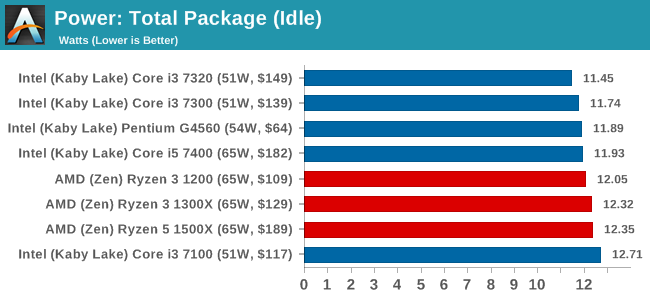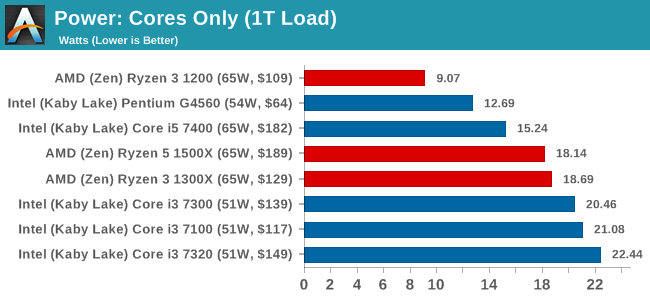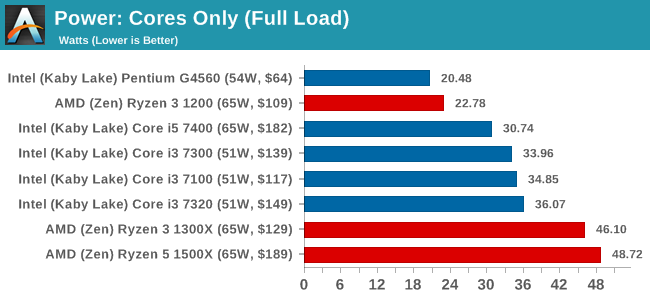The AMD Ryzen 3 1300X and Ryzen 3 1200 CPU Review: Zen on a Budget
by Ian Cutress on July 27, 2017 9:30 AM EST- Posted in
- CPUs
- AMD
- Zen
- Ryzen
- Ryzen 3
- Ryzen 3 1300X
- Ryzen 3 1200
Power Consumption
For our power consumption readings, we run a Prime 95 load and slowly ramp up the number of threads in play, taking power data from the internal CPU registers that report for when turbo modes or thermal modes should activate. Depending on the CPU access, we can get data that varies from the full package down to individual cores, uncore, integrated graphics and DRAM controllers.
For the Ryzen CPUs, the API pulls out the total package power consumption first.



At idle, all the CPUs are pretty much equivalent. The cores are fully idle here, leaving the rest of the chip active enough for tick-over. As we ramp up the load, the higher-frequency Ryzen CPUs move towards their 65W TDP, with the Ryzen 3 1300X almost being spot on at 64.2W. The Intel CPUs are clocked higher, but only have two cores to contend with. The Ryzen 3 1200 is clocked lower than the Ryzen 3 1300X, hitting a better efficiency point in the Zen design. This ultimately bodes well for upcoming quad-core SKUs in laptops.


One of the odd things about the power consumption of the Ryzen 3 CPUs is the difference between how much power the cores internally measure compared to the full power consumption of the package measured as a whole, including the Infinity Fabric, DRAM controllers, IO and such. For the Ryzen 3 1200 for example, at full load the package has a power consumption of 40.43 W total, but the cores only count for 23.05W, leaving 17.38W on the table for the non-core elements in the chip. If we compare that to the Ryzen 5 1500X, we have 68.79W for the package and 49.69W for the cores, a 19.1W difference. For the Ryzen 7 1700X, it becomes 81.51W for the package and 62.10W for the cores, a 19.4W difference.
On the high-end chips, the difference is a smaller portion of the full power consumption, but on the Ryzen 3 processors the cores are only 57% of the power consumption, leaving 43% for the rest of the chip. A lot of this power could be the inter-CCX infinity fabric path, which means that packages like EPYC are giving away a lot of power to IF. If it is more other features, it could spell a number of problems for upcoming mobile chips, limiting the lower bounds of the power consumption. Naturally, I actually want to get my hands on to an EPYC processor in my own lab to see if we can pin down what is happening here.










140 Comments
View All Comments
wallysb01 - Thursday, July 27, 2017 - link
And you're an N=1. Intel iGPUs are more than enough for plenty uses now, and have been for a while actually. I built a cheap office machine for my wife that we use also use for streaming, for example, I even played some DOTA on it for a time. That computer has the G3220 and it works just fine. HTPC, office/web, even a little light/cheap gaming... Intel iGPU is all you need. The extra $50+, power use and space (for those that want small form factors) for a dGPU is just thrown in the garbage and lit on fire for most computer use.DanGer1 - Saturday, July 29, 2017 - link
If you want to compare to an APU you will have to wait for Raven Ridge and I am pretty sure we all know what integrated Radeon graphics compare to Intel....no contest. It is my understanding that Raven Ridge will be coming out on 14nm+ as well. AMD will have a clear win in this segment.KAlmquist - Thursday, July 27, 2017 - link
Currently, the lowest priced AM4 motherboard on Newegg is the ASRock A320M-HDV for $55 including shipping. There are a number of Intel LGA 1151 boards for less than that, starting with the GIGABYTE GA-H110M-M.2 for $48 and the ASRock H110M-HDS R3.0 for $51. So motherboard costs currently favor Intel at the low end. That said, the price differential is small, and may disappear over time as manufacturers recover their development costs.DanGer1 - Saturday, July 29, 2017 - link
Right, but you can overclock the R3 without needing to by a "K" and it comes with a cooler.SlowSpyder - Thursday, July 27, 2017 - link
Looks like AMD aimed for the i5 7400, but priced it with the i3's. Not much to complain about here.Otritus - Thursday, July 27, 2017 - link
The third(last) chart on the first page is listed as Comparison: AMD Ryzen 3 1300X when it should be Comparison: AMD Ryzen 3 1200Otritus - Thursday, July 27, 2017 - link
On the second page it says fury x uses hdm not hbmDrake H. - Thursday, July 27, 2017 - link
just missed the dolphin...rocky12345 - Thursday, July 27, 2017 - link
Great review thank you.After watching a review on YT from AdoredTV and reading your review here I feel the R3 Ryzen's are pretty much what we all expected. They beat that useless Pentium CPU and duke it out with the i3's and the non K i5's. On AdoredTV he got the 1200 to 3.9Ghz and the 1300x to 4.0Ghz on the stock coolers with good temps. Once overclocked they really show their value in everything more so in the games. They both make the useless Pentium and the i3's look pretty sad.
Another thing to look at is the R3's come with a stock cooler and are unlocked as well right their that adds value because unlike a K CPU you do not need to buy a cooler and if you get a Intel non K you can't make them faster by overclocking the Intel CPU's.
rocky12345 - Thursday, July 27, 2017 - link
Made a mistake it is Hardware Unboxed not AdoredTV I was referring to in my first comment. My bad sorry.